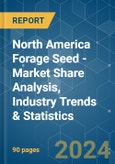Key Highlights
- Alfalfa is the Largest Crop: Alfalfa is having high demand in the region by dairy farmers for animal feed, it can be harvested 10-12 times per crop season and has high nutritional protein content.
- United States is the Largest Country: The United States forage market has increased during the study period due to factors such as Increasing livestock, dairy industry, meat industry, and fragmentation of land.
- Forage Sorghum is the Fastest-growing Crop: The growing demand for animal products and higher prices in the international market, and the demand for livestock feed by dairy farmers has encouraged farmers to cultivate.
- United States is the Fastest-growing Country: The demand for Forage Crops in the country is expected to increase in the future due to an increase in the demand for livestock feed, and the fragmentation of land.
North America Forage Seed Market Trends
Hybrids is the largest Breeding Technology
- Hybrid seed is the largest segment in the region because of the increase in yield, resistance to diseases, and adaptability to different climatic conditions.
- In 2021, the non-transgenic forage hybrid seed was the largest sub-segment, with 98.0% of the hybrid forage seeds. It is because of the perceived effect of transgenic traits on livestock and animal health.
- There is a change in the trend as farmers cultivate transgenic forage crops with traits that make feed easy to digest. Therefore, in the future, the transgenic segment is expected to see growth along with non-transgenic.
- Alfalfa and corn are the most hybridized among the forage crops as they have more demand in the processing industry in pellet feeds and ethanol production, respectively.
- The United States is the country's largest user of hybrid seeds because of the high replacement rate, higher demand, and sometimes unfavorable weather conditions. To overcome weather conditions and soil requirements, the country's farmers use more hybrid seeds to increase production and yield from the less cultivated area. Therefore, the demand for hybrid seeds is expected to increase during the forecast period.
- Open-pollinated varieties are used by medium-scale farmers to reduce the cost of cultivation and have no molecular content in the seed. Canada is the largest user of OPVs in the cultivation of forage crops in the region. Therefore, countries such as Canada and Mexico, which have low approvals for genetically modified crops, will still use open-pollinated varieties during the forecast period.
United States is the largest Country
- The North American region accounted for 37.3% of the global forage seeds market in 2021 due to increased demand for forage as feed, meat consumption, and weather conditions.
- In the region, forage crops are preferred due to benefits such as providing nutrients to the soil, less water required for irrigation, and investments in improving production with higher yields using advanced technologies.
- The greatest demand for forage seeds is in the United States due to the high demand for forage as feed and the increase in the cattle population in the country.
- For instance, according to FAO, the number of cattle in the United States increased from 91.8 million in 2016 to 93.7 million in 2020. Thus, dairy farmers' demands are expected to be met, and forage cultivation is expected to increase during the forecast period.
- In 2021, the United States market share was 25.0% of the global forage sorghum seed market, followed by alfalfa 14.6% of the global alfalfa due to high profits, less irrigation required, and high nutritional values for livestock.
- Canada also has a share of about 35.5% in the region in 2022 due to factors such as the government's support and an increase in the demand for feeding animals by the meat processing industry.
- For instance, in 2021, the Canadian government invested about USD 2.6 million to help the alfalfa growers association with advanced technologies and help in higher yield. Therefore, production is expected to increase, and demand for seeds for the forage crops will increase during the forecast period.
- Therefore, owing to the above factors, the demand for forage seeds is expected to increase in the region during the forecast period.
North America Forage Seed Industry Overview
The North America Forage Seed Market is moderately consolidated, with the top five companies occupying 43.41%. The major players in this market are Bayer AG, Corteva Agriscience, DLF, KWS SAAT SE & Co. KGaA and Land O'Lakes, Inc. (sorted alphabetically).Additional Benefits:
- The market estimate (ME) sheet in Excel format
- 3 months of analyst support
Table of Contents
Companies Mentioned (Partial List)
A selection of companies mentioned in this report includes, but is not limited to:
- Advanta Seeds - UPL
- Ampac Seed Company
- Bayer AG
- Corteva Agriscience
- DLF
- Groupe Limagrain
- KWS SAAT SE & Co. KGaA
- Land O'Lakes, Inc.
- Royal Barenbrug Group
- S & W Seed Co.
Methodology

LOADING...










